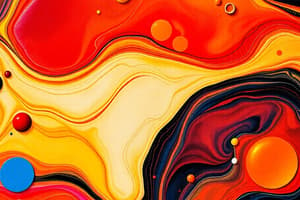Podcast
Questions and Answers
Which of the following materials can be characterized as opaque?
Which of the following materials can be characterized as opaque?
- Plastic
- Water
- Glass
- Wood (correct)
Which property distinguishes a transparent material from a translucent material?
Which property distinguishes a transparent material from a translucent material?
- Transparency allows complete light passage. (correct)
- Translucency reflects all light.
- Transparency can be seen through clearly. (correct)
- Translucent materials absorb more light.
Which pair of materials is correctly grouped based on their shiny properties?
Which pair of materials is correctly grouped based on their shiny properties?
- Glass bowl and cotton shirt
- Steel spoon and plastic toy
- Steel spoon and glass bowl (correct)
- Plastic toy and steel spoon
What characteristic typically defines soluble materials?
What characteristic typically defines soluble materials?
Which of the following best explains why materials are grouped together?
Which of the following best explains why materials are grouped together?
Which material is likely to exhibit lustre when freshly cut?
Which material is likely to exhibit lustre when freshly cut?
What property of materials is typically related to their ability to reflect light?
What property of materials is typically related to their ability to reflect light?
What happens to metals like iron or aluminium over time that affects their lustre?
What happens to metals like iron or aluminium over time that affects their lustre?
Which method can be used to assess the lustre of a material without cutting it?
Which method can be used to assess the lustre of a material without cutting it?
Which combination of materials is likely to include shiny examples?
Which combination of materials is likely to include shiny examples?
Flashcards are hidden until you start studying
Study Notes
Properties of Materials
- Materials are assessed based on their properties for suitability in making objects.
- Lustre is a property observed in certain materials, particularly metals, which appear shiny when freshly cut.
- Metals such as iron, copper, aluminium, and gold are typically shiny, though they can become dull due to environmental exposure.
- Materials can be classified as opaque, transparent, or translucent, based on light transmission.
- Properties like solubility (soluble vs. insoluble), texture (rough vs. smooth), and hardness (hard vs. soft) also determine material usage.
Observations and Activities
- Freshly cut surfaces of materials can reveal lustre; this can be checked by cutting or rubbing surfaces with sandpaper.
- Practical experiments can include adding different substances (sugar, salt) to water in glasses to observe reactions.
- Grouping materials by properties simplifies studying their characteristics and identifying patterns.
Material Usage
- Objects can be made from a single material or a combination of several types.
- Selection of material for an object is often influenced by the material’s properties – e.g., a tumbler would be made from glass, plastic, or metal, while cooking vessels should avoid paper-like materials.
Everyday Examples
- Consider everyday items made from specific materials, such as wood, plastic, or metal.
- Identify shiny objects, like glass bowls and steel spoons, versus non-shiny items, like cotton shirts and plastic toys.
Grouping and Classification
- Grouping materials based on similarities in properties aids in organization and understanding.
- Everyday materials such as paper, cardboard, wood, and metals can exhibit diverse properties, influencing their applications in daily life.
Studying That Suits You
Use AI to generate personalized quizzes and flashcards to suit your learning preferences.




